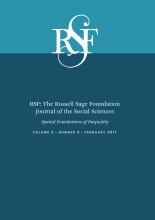Research Article
Open Access
Segregation as a Source of Contextual Advantage: A Formal Theory with Application to American Cities
Lincoln Quillian
RSF: The Russell Sage Foundation Journal of the Social Sciences February 2017, 3 (2) 152-169; DOI: https://doi.org/10.7758/RSF.2017.3.2.07
Lincoln Quillian
aProfessor of sociology at Northwestern University and chair of the Institute for Policy Research’s Program on Urban Policy and Community Development

REFERENCES
- ↵Chetty, Raj, Nathaniel Hendren, and Lawrence F. Katz. 2015. “The Effects of Exposure to Better Neighborhoods on Children: New Evidence from the Moving to Opportunity Experiment.” NBER working paper no. 21156. Cambridge, Mass.: National Bureau of Economic Research. Accessed July 1, 2016. http://www.nber.org/papers/w21156.
- ↵
- Clark, Kenneth B. 1989. Dark Ghetto: Dilemmas of Social Power, 2nd ed. Middletown, Conn: Wesleyan University Press.
- ↵Coleman, James Samuel. 1966. Equality of Educational Opportunity. Washington: U.S. Department of Health, Education, and Welfare.
- Denton, Nancy, and
- Douglas S. Massey
- ↵James, David R., and Karl E. Taeuber. 1985. “Measures of Segregation.” In Sociological Methodology 1985, edited by Nancy B. Tuma. San Francisco: Jossey-Bass.
- Lieberson, Stanley. 1980. A Piece of the Pie: Black and White Immigrants Since 1880. Berkeley: University of California Press.
- ↵Logan, John R. 2011. “Separate and Unequal: The Neighborhood Gap for Blacks, Hispanics, and Asians in Metropolitan America.” US2010 Project report. Providence, R.I.: Brown University. Accessed July 1, 2016. http://www.s4.brown.edu/us2010/Data/Report/report0727.pdf.
- ↵Logan, John R., and Brian Stults. 2011. “The Persistence of Segregation in the Metropolis: New Findings from the 2010 Census.” Project US2010 census brief. Providence, R.I.: Brown University. Accessed April 1, 2016. http://www.s4.brown.edu/us2010.
- ↵
- ↵
- Massey, Douglas S., and
- Nancy A. Denton
- ↵Massey, Douglas S., and Nancy A. Denton. 1993. American Apartheid: Segregation and the Making of the Underclass. Cambridge, Mass.: Harvard University Press.
- ↵Minnesota Population Center. 2011. National Historical Geographic Information System: version 2.0. Minneapolis: University of Minnesota.
- Orfield, Gary, and Chungmei Lee. 2005. “Why Segregation Matters: Poverty and Educational Inequality.” Cambridge, Mass.: The Civil Rights Project of Harvard University.
- ↵Pattillo, Mary. 1999. Black Picket Fences: Privilege and Peril Among the Black Middle Class. Chicago: University of Chicago Press.
- ↵Peterson, Ruth D., and Lauren J. Krivo. 2010. Divergent Social Worlds: Neighborhood Crime and the Racial-Spatial Divide. New York: Russell Sage Foundation.
- ↵
- Quillian, Lincoln
- ↵
- Sharkey, Patrick. 2013. Stuck in Place: Urban Neighborhoods and the End of Progress Toward Racial Equality. Chicago: University of Chicago Press.
- ↵
- ↵Wilson, William Julius. 1987. The Truly Disadvantaged: The Inner City, the Underclass, and Public Policy. Chicago: University of Chicago Press.
- ↵
- Wodtke, Geoffrey T.,
- David J. Harding, , and
- Felix Elwert
In this issue
Segregation as a Source of Contextual Advantage: A Formal Theory with Application to American Cities
Lincoln Quillian
RSF: The Russell Sage Foundation Journal of the Social Sciences Feb 2017, 3 (2) 152-169; DOI: 10.7758/RSF.2017.3.2.07
Jump to section
Related Articles
- No related articles found.
Cited By...
- No citing articles found.





